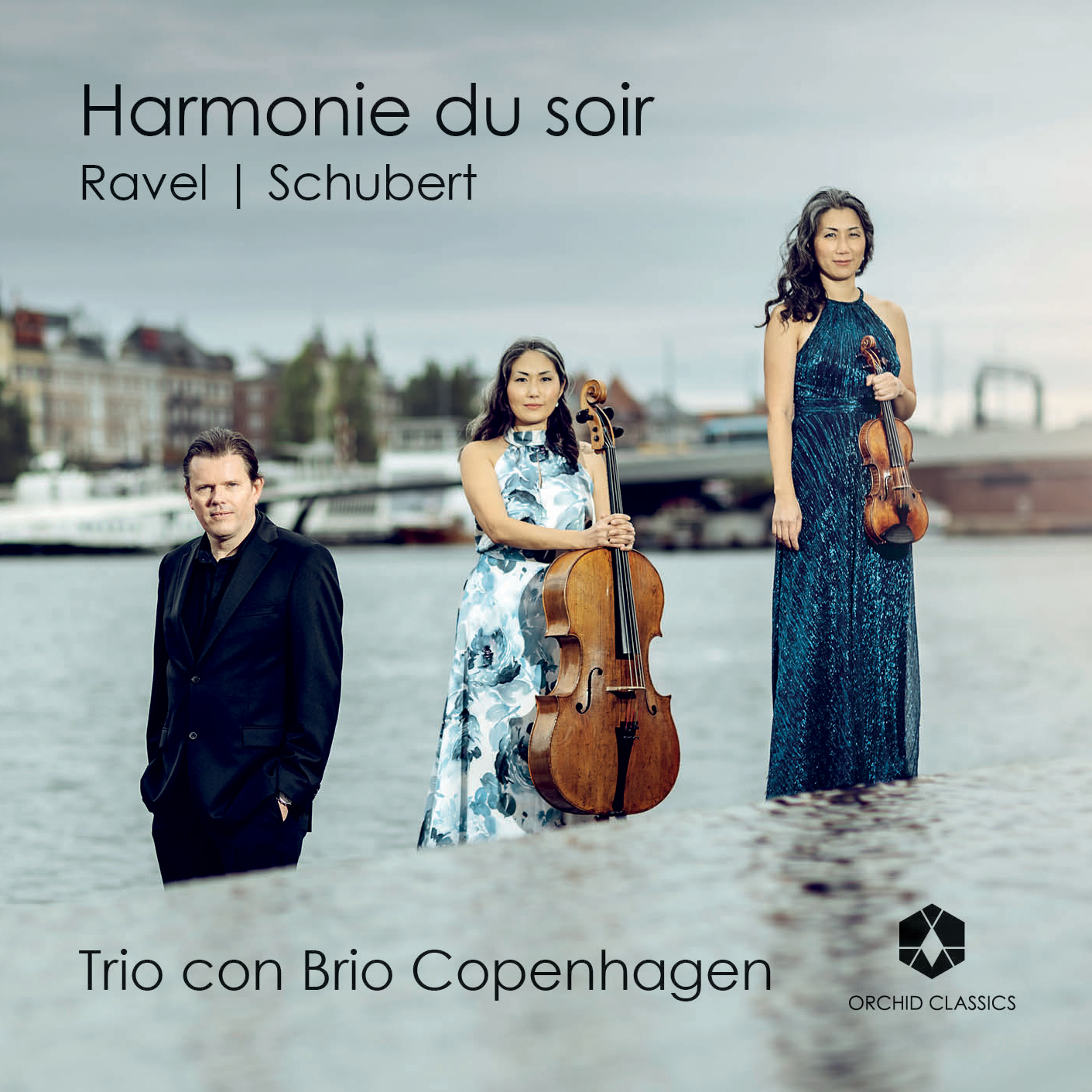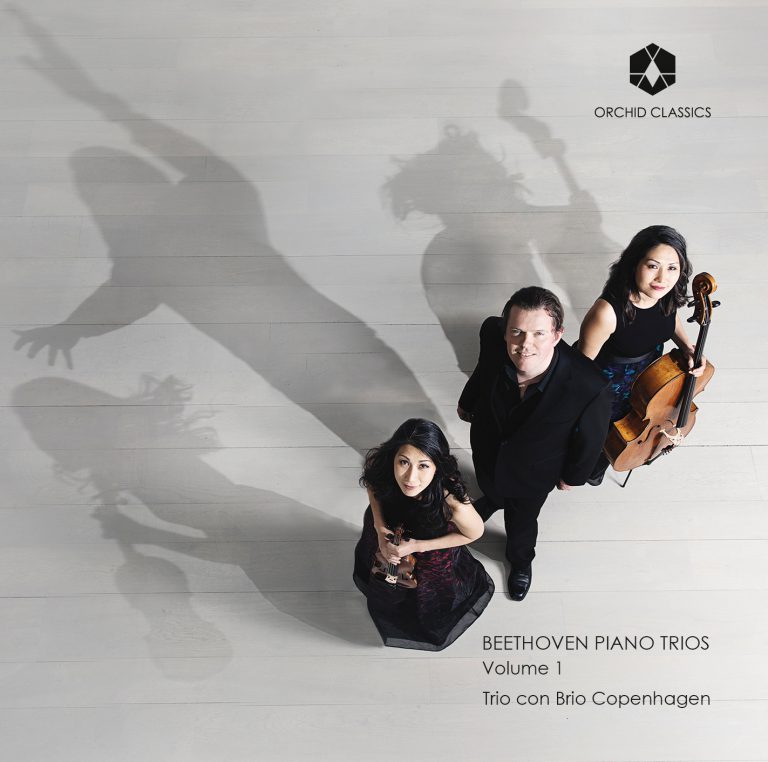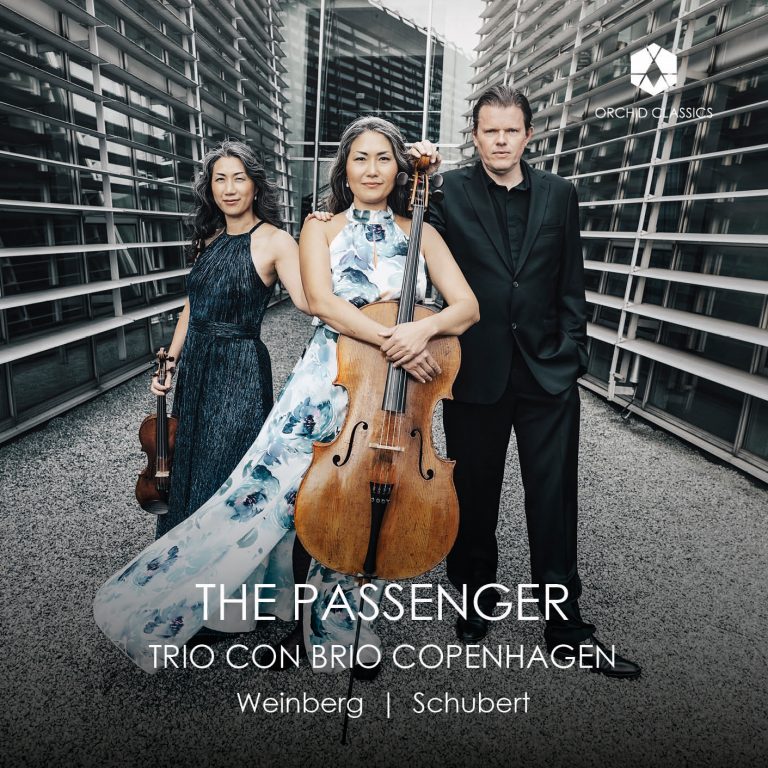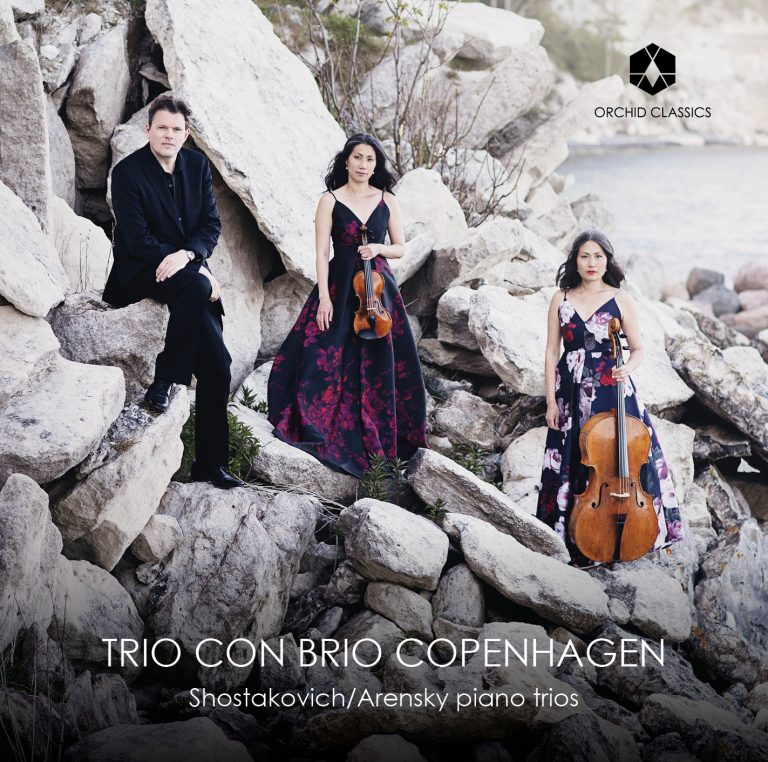Artist Led, Creatively Driven

HARMONIE DU SOIR
Ravel | Schubert
Trio con Brio Copenhagen
Release Date: Feb 28th 2025
ORC100363
HARMONIE DU SOIR
Maurice Ravel (1875-1937)
Piano Trio in A minor (1914)
1. I Modéré
2. II Pantoum. Assez vif
3. III Passacaille. Très large
4. IV Final. Animé
Franz Schubert (1797-1828)
Piano Trio No.1 in B-flat major, Op.99 D.898 (1827)
5. I Allegro moderato
6. II Andante un poco mosso
7. III Scherzo. Allegro – Trio
8. IV Rondo. Allegro vivace – Presto
Trio con Brio Copenhagen
Soo-Jin Hong, violin
Soo-Kyung Hong, cello
Jens Elvekjaer, piano
Both Maurice Ravel’s Piano Trio and Franz Schubert’s Piano Trio No.1 in B flat major are works that transcend the age in which they were written. Despite being composed in times of inner and outer darkness, they possess an illuminating force that makes music a magic medium. The effects used to attain this, however, differ considerably.
In his trio Ravel forms sound into a glitter ball that grants access to distant realms. Schubert, on the other hand, moulds time with his tuneful melodies. Using these as leads, we can look back to distant times of legend, or forwards towards a future full of adventure that perhaps awaits us.
When Ravel composes his piano trio in 1914 in the Atlantic coastal town of St-Jean-de-Luz in the French part of the Basque Country, the First World War is looming ever closer. We can almost hear the bugles’ call to arms in the piano part during the final movement. Until that point, we sense that Ravel lived in an age where the Orient exerted a strong fascination. The title of the second movement is Pantoum, which refers to Malaysian Pantun poetry, where the lines of verse are repeated according to a laid-down pattern. This technique was made use of by a number of French authors, best known from Baudelaire’s poem Harmonie du soir – Evening harmony – which portrays a mood related to that which we experience in Ravel’s trio.
Harmonie du soir
Voici venir les temps où vibrant sur sa tige
Chaque fleur s’évapore ainsi qu’un encensoir;
Les sons et les parfums tournent dans l’air du soir;
Valse mélancolique et langoureux vertige!
Evening harmony
Now comes the time of day on trembling stem below
Each censer-seeming flower starts to evaporate;
In evening air the sounds and perfumes all gyrate;
A melancholy waltz and languid vertigo!
When Schubert, in the autumn of 1827 – a year before his death – composes his Piano Trio No.1, he is busy at work on his Winterreise song cycle. In 24 songs to texts by Wilhelm Müller, Schubert enacts various aspects of Weltschmerz. In the light of this, the sparkling music that typifies Piano Trio No.1 from the outset seems to be a miracle. The notes are flung into the air with irresistible force. And the same applies to the final movement, with its effervescent good spirits. Perhaps, though, something else is concealed beneath the positive surface. The main theme is modelled on the notes of the song Skolie, where there is hidden pain, even in the lovely light of a May morning.
Skolie
Lasst im Morgenstrahl des Mai’n
Uns der Blume Leben freun,
Eh’ ihr Duft entweichet!
Haucht er in den Busen Qual,
Glüht ein Dämon im Pokal,
Drinking Song
In May’s morning sunshine bright
In flower’s life let us delight
Ere her scent will languish!
Should its rays cause pain as well,
In the cup a demon dwells
That can end such anguish.
Maurice Ravel
Trio for piano, violin and cello in A minor (1914)
All of the trio’s four movements begin quietly. With supreme care and gentleness, Ravel takes a single musical idea as his point of departure, one which subsequently expands and on several occasions leads to moments of ecstasy.
In the first movement we hear discreet bells in the asymmetrical, rocking rhythms of the piano which, inspired by the Basque dance Zortzico, send a greeting to Ravel’s Spanish mother. New, warm colours are added when the two string instruments join the piano with intimate, honey-sweet melodies. And with the piano struck as if it were a harp there is a touch of an exotically enticing world. At the same time, the music is characterised by a deep passion that is in evidence in sudden, violent accelerandi before the movement dies away with lonely-sounding notes from the depths of the piano.
In the tightly structured Pantoum we find ourselves in a whirling, swirling waltz world. As in La Valse, composed a few years later, Ravel cultivates a mood of surreal doom. With quivering notes squeezed out by the strings, and with a glittering sound from the piano inspired by the oriental percussive instruments Ravel had heard in the Balinese gamelan orchestra in Paris, it is dizzying music. On the verge of burning up from within.
The third movement Passacaille is resonant architecture. A calm heart saturated in dark colours between the other movements drenched in light. Here Ravel makes use of the ancient passacaglia form of variation, with everything based on a constantly reiterated bass theme. With procession-like certainty, we are led into the music by the piano. And when the strings play con sordino at the end of the movement, it is almost as if time stands still.
With a finely meshed network of overtones and quick repetitions of notes in the strings, Ravel creates a carpet of sound which, like shimmering sun-mist, bathes the music in an unreal gleam. With oriental-sounding pentatonic harmonies and changing time signatures we find ourselves in an unpredictable musical world. The three instruments follow each other closely in wave-like movements, with intertwining delicate, tuneful melodies. With the marking Animé, Ravel makes it clear that this is a study in enthusiasm. Expressed in music and with a call to external action.
Franz Schubert
Trio for piano, violin and cello in B-flat major, D.898 (1827)
When the Piano Trio in B-flat major was published, eight years after Schubert’s death, Robert Schumann got his hands on the music. He writes enthusiastically: ‘A glance at Schubert’s trio, and all human misery disappears, and the world gleams in a new splendour.’ And Schumann cannot resist comparing it with Schubert’s Piano Trio in E flat major, which also derives from the last year of Schubert’s life. Unlike the darker and more fateful E flat major trio, Schumann considered the B flat major trio to be ‘more passive, lyrical and feminine’.
Today, we would not characterise music on the basis of a particular gender. But it certainly is true that Schubert’s Piano Trio in B flat major is not just a playful, vigorous piece of music characterised by an infectiously positive view of life. The lyrical and tuneful aspects are to the fore, and the music is well-balanced to a rare degree.
From the very outset, it is clear how the optimism radiates out from the main theme, with energetic triplets in the strings and a rhythmically taut accompaniment in the piano. The music is unstoppable, and when a fervently glowing second theme is presented in the cello a little later, there can be no doubt that we are in highly capable musical hands.
So it is all the more alarming when the music suddenly ebbs away. The silence rises like a dark shadow and questions what has gone before. Is the life-asserting music of the opening an illusion? And when the music starts up again, it is in a darker mood, with notes from outside the harmonic framework. We become aware that this is music with various layers of possible meaning. The opposite of life, death, is a reality.
And after this, in the development section, the drama becomes more salient. The idyllic Biedermeier atmosphere, very much in fashion in Schubert’s time, has now completely evaporated. This split is a fundamental feature of Schubert’s music, and the unrest increases towards the conclusion of the long first movement. Violin, cello and piano fling the same notes out again and again in a great imaginary ‘Why?’ before Schubert, with a sparkling, powerful conclusion, allows life to continue.
The beginning of the calm second movement is a musical heaven. With a fervent cello solo above velvet-smooth, cradling piano notes, everything exudes peace. And when the singing violin joins in, there is no end to the sheer beauty. Once again in this movement, Schubert is generous with time. Eternity is everywhere while the music streams. But despite the beauty it is a restless musical world. Schubert repeatedly seeks a harmonious haven. But without success. Schubert was a wanderer, and towards the conclusion it is as if he looks back longingly over his shoulder while the same motifs are reiterated time and time again.
In the third movement, marked Scherzo, Schubert celebrates his playful lightness. With an ingeniously descending motif in the piano, the strings are enticed into a cheerful exchange. And with echoes of naïve folk music at times in the trio Schubert also finds space for the simple country life that he acquired a taste for on his much-loved excursions to Wienerwald and other Austrian provinces.
The concluding Rondo is sheer festivity. The music is unstoppable, and the opening dancing theme reappears again and again. And it is not alone. In a contrasting theme the whole trio is brought together in an energetic theme where the notes are carved out at full strength. The elegantly dance-like and the exuberant take over from each other without warning.
And Schubert is a master at instilling life into the dancing notes, using rhythmical measures. At times the music forms a ring, and the piano imitates a musical box, with the same notes being constantly repeated. With its laconic tone it is reminiscent of the final song in Winterreise – Der Leiermann – where we meet the hurdy-gurdy man who, barefoot on the ice, is forced to realise that no one wishes to hear his music.
But here in the Piano Trio in B flat major things develop differently. When, towards the conclusion, the music starts idling, like a car in neutral, caught in its own harmonic spinning, Schubert plays his trump card. With a sudden introduction of an exuberant Presto everything changes, and with an attitude of rejoicing the trio ends in a splendid B flat major.
© Trio con Brio Copenhagen & Esben Tange
Trio con Brio Copenhagen
Acknowledged as one of the world’s finest piano trios, the Trio con Brio Copenhagen’s multifaceted members are not only performing artists who tour extensively, but also esteemed recording artists, artistic directors and educators. Founded at the University of Music and Performing Arts in Vienna in 1999, the trio is now based in Copenhagen and tours worldwide. The Trio was born out of an idea of the coming together of ‘musical pairs’ – of the two Korean-born sisters, Soo- Kyung Hong (cello) and Soo-Jin Hong (violin), with Soo-Kyung and her husband, Danish pianist Jens Elvekjaer.
They quickly gained a reputation for their fresh and contemporary approach to the core repertoire. “Works by Beethoven, Schubert and Brahms are transformed in their hands into the alive-and-kicking music of today” said Danish Broadcasting’s Esben Tange. Winning almost all of the major competitions for piano trio – including the ARD (Munich), Vittorio Gui (Florence), Trondheim Competition (Norway), Kalichstein-Laredo-Robinson International Trio Award (USA) and three major Danish awards: P2 Artists Prize, Carl Nielsen and Anne Marie Carl-Nielsen’s Honorary Award and Wilhelm Hansen Foundation’s Honorary Award (Denmark) – they are regularly heard at the world’s leading venues and concert series. Among these, Carnegie Hall, Lincoln Center, Wigmore Hall, Berlin Pierre Boulez-Saal, Concertgebouw Amsterdam, Elbphilharmonie Hamburg, Seoul Arts Centre, Louvre Paris and of course their beloved “home venues”, DR Koncerthuset and the Tivoli Concert Hall, in Copenhagen.
Trio con Brio Copenhagen plays a central role in Scandinavia’s vibrant contemporary music scene. Leading composers have dedicated works to the Trio. They were enormously honoured that Per Nørgård dedicated to them a new piece celebrating his 80th birthday in 2012. In January 2016 the trio presented the world premiere of Bent Sørensen’s Triple Concerto with the Danish National Symphony Orchestra, a work that won the prestigious Grawemeyer Award and is recorded by the trio, DNSO and Jukka-Pekka Saraste. They premiered Sven-David Sandström’s Triple Concerto, a work that marks his 70th birthday.
The ensemble’s recordings have received tremendous critical acclaim. The album of Shostakovich and Arensky trios (Orchid Classics) was a Gramophone “Editor’s Choice” and singled out by BBC Music Magazine as a “Chamber Choice” of the month. The disc also won the German Record Critics’ Award (Preis der deutschen Schallplattenkritik). An album featuring the complete Beethoven piano trios (Orchid Classics) garnered broad, enthusiastic praise from critics and fans alike with the BBC Music Magazine calling it “a triumph.” The Trio has also recorded the work of leading Scandinavian composers, including Per Nørgård, Bent Sørensen and Sven-David Sandström, who have written works for the group. Reviews are fulsome. “One of the greatest performances of chamber music I’ve ever encountered,” praised American Record Guide. Gramophone wrote, “Superb…Any group would be hard- pressed to imitate this blend of verve and poise…” Their Mendelssohn album was chosen by the UK’s Classic FM as the Best Chamber Music Disc of the year: “Every phrase soars and pulsates with the excitement of a fresh discovery as the Copenhagen players go the full distance with playing of skin-rippling sensitivity… sensational playing…”. Their Tchaikovsky and Smetana recording was hailed by The Guardian, “… Trio con Brio Copenhagen scale Tchaikovsky’s heights with the verve their name suggests …” The trio’s most recent recordings of the complete Beethoven piano trios were received with the highest critical acclaim, with comments such as “… I was struck… by the feeling of improvisation; of three players moving forward together into a strange and wonderful new world…” (Gramophone).
Trio con Brio Copenhagen serves as artistic directors of the annual festival, Chamber Music at Lundsgaard, and the Hellerup Chamber Music Society in Copenhagen.
Soo-Jin plays an Andrea Guarneri violin, Soo-Kyung plays a Grancino cello, and Jens is Denmark’s first Steinway Artist. Both string players are endorsed by Jargar Strings and Thomastik-Infeld Vienna. All three members of the trio knew right from the start that they would find their musical identities as a piano trio: “There is something about the configuration of a trio, about that triangle, that somehow focuses and amplifies the special understanding that we all have as people and as musicians. It is both a freedom and a fulfilment”.









